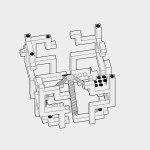“A score of weightless ideograms like water insects that seem to whirl on a brass structure screened by gauze thread”. Italo Calvino, Gli Effimeri. (Italian original at the end of the post).
An artist that worked with a wide variety of media (ceramic, plaster, metal wire, drawings, and words), Fausto Melotti was an influential figure in the Italian artistic panorama of the XXth Century, who explored the boundary between abstraction and figurative art.
After studying physics, mathematics and electrical engineering, Melotti enrolled at the Brera Academy of Arts in Milan, under the professorship of Lucio Fontana. Despite such a change, he never lost interest in the sciences and in 1935 he described the relationship of abstract art to architecture, music, math and science writing: “Greek architecture, Piero della Francesca’s painting, Bach’s music, rationalist architecture — these are all ‘exact’ arts.”
While teaching modern plastic arts at the Scuola Artigianale in Cantù, in 1935, Melotti wrote: “We believe that we arrive at art through art, the fruit of personal insight: thus, all our efforts consist in teaching the small heroic act of thinking with our own brains”. (Quadrante, II, nos. 14-15, Milan, June-July 1934).
Abstraction was his main preoccupation when in 1931 M. joined Abstraction-Création, the movement founded in Paris in the same year by Van Doesburg, Seuphor, Vantogerloo. Born from a family of musicians, the artist identified the possibility of “musical abstraction” in the field of the figurative arts:
“Slowly music has ensnared me, disciplining me with its laws, distractions, and digressions in a balanced discourse.” (Speech made at the Rembrandt Prize, Milan, 1973.). This phase of works was characterized by a research into musical principles applied to sculpture: rhythm, harmony, counterpoint.
Throughout and after the war, Melotti progressively distanced himself from abstract art to experience more figurative and surreal themes and use ceramics instead of metal. The “Teatrini” (small theaters, echoing Joseph Cornell’s assemblages but with an Arte Povera accent) date back to this phase. The series consisted of small rectangular clay or terracotta boxes filled with surreal figures and objects.
In the same years he began a rich series of collaborations with Italian renowned architects such as Figini and Pollini, B.B.P.R., and, above all, Gio Ponti, with whom he worked for the Villa Planchart in Caracas (1956) and the Villa Nemazee in Teheran (1960). A frequent collaborator for the architecture and arts magazine Domus, the artist provided written criticism for many decades.
Melotti’s late sculpture, to which we dedicate most of the following gallery, was mainly made with brass wire and sheeting, and echoed Giacometti’s surrealism of “Palace at 4 a.m.” (see in Socks: “An Immaterial Drawing in Space“) as well as Calder’s “Circus”. Among the sculptures composed between the 1960’s and the early 1980’s, Gli effimeri (1978) was a particularly delicate ensemble to which Italian writer Italo Calvino, a dear friend of Melotti throughout his life, dedicated the lines at the beginning of this post.
(“Una partitura d’ideogrammi senza peso come insetti acquatici che sembrano volteggiare su di una spalliera d’ottone schermata da un filo di garza”. I.Calvino, Gli Effimeri.)
All images belong to the copyright holder and are extracted from the catalog of the exhibition “Melotti” at the Galleria Nazionale d’Arte Moderna Roma in 1983. (Electa), except the last one, Gli Effimeri, photographer unknown.


Leave a Reply